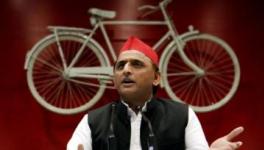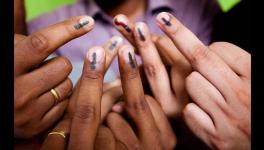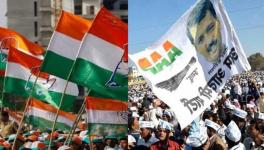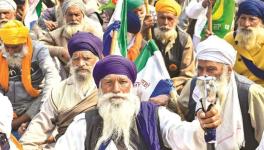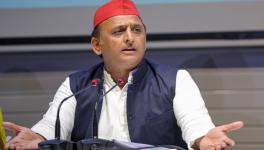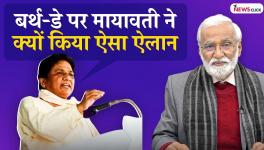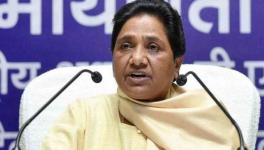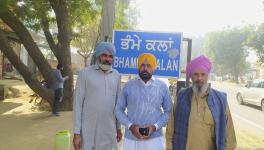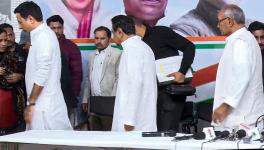Punjab yet to see Strong SC Leaders Despite 32% Dalit Population: Prof Ronki Ram
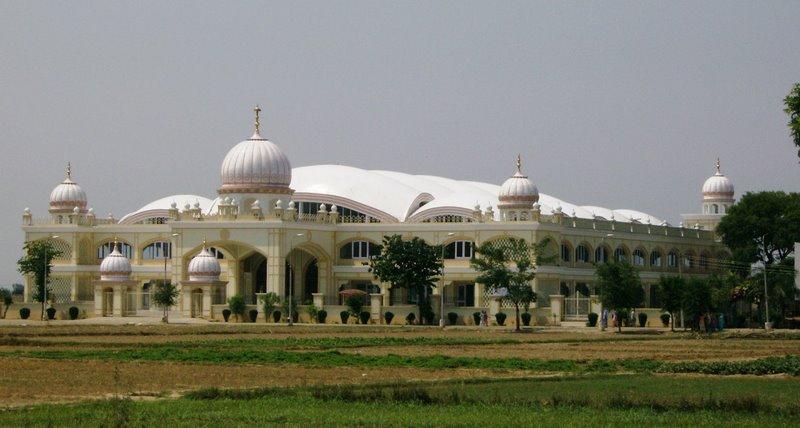
The postponement of Punjab Assembly elections on account of Guru Ravidass Jayanti on February 16, is a clear indication of the reinforcement of the SC’s identity in the state, which has the highest percentage of SC population (31.94%) in the country. In an email interview with NewsClick, Prof Ronki Ram, former Dean (Faculty of Arts), Shaheed Bhagat Singh Chair Professor of Political Science, Panjab University, explains the trajectory of the political journey of SCs in Punjab, the strong presence of Deras and why the community has not thrown up strong leaders as yet.
TN: Can you explain the political journey of the Scheduled Castes in Punjab? And what electoral trends can be observed among SCs – past and current?
RR: The political journey of Scheduled Castes (SCs) in Punjab began with the formation of the historic Ad Dharm movement in 1926. The Ad Dharm movement was founded by Babu Mangu Ram Mugowalia, who earlier was active in the Ghadar Movement and was involved in the herculean task of smuggling weapons to India for armed revolt against British rule. However on the way to India from the US, he was arrested along with four other Ghadarites and was sentenced to death. But, timely help by their German sympathisers saved his life.
Thereafter, he (Mugowalia) went underground and finally reached India in 1925 after spending 16 years abroad. He was surprised to find that in all these years nothing had changed in the caste-based social set-up of the society. To cut the fetters of caste, he founded the Ad Dharm movement. This was the only movement of its kind in the region aimed at generating political awareness among the SCs.
After establishing its headquarters (Ad Dharm Mandal) in Jullundur – now spelt as Jalandhar – the Ad Dharm movement intensified its lobbying with the British government to get a separate religion for SCs. In 1931, the British government notified Ad Dharm as an exclusive religion of the lower castes. Consequently, 418,789 lower castes reported as Ad Dharmi in the 1931 Punjab Census.
Another major development that underlined the initial political journey of SCs in Punjab was their successful participation in the maiden Punjab Provincial Assembly elections of 1936-37. The Ad Dharmis supported independent candidates in the eight reserved SCs constituencies throughout the undivided Punjab province. Their caste-based consolidation for political support helped seven out of the total eight independent candidates, who won the election.
In the second crucial Punjab Legislative Assembly election of 1945-46, on the eve of Independence, the Ad Dharmi candidates contested as Unionists as well as Independents. Both the Unionists and Independents won 10 seats each. Babu Mangu Ram Mugowalia got elected as a Unionist candidate from Hoshiarpur constituency; and in 1996, Babu Kanshi Ram won from there as a Member of Parliament.
The political journey of SCs in Punjab picked up momentum with the formation of the Punjab unit of the All India Scheduled Castes Federation (SCF), which contested three elections in the state – one provincial election in 1946 and two general elections in 1952 and 1957. Though it failed to open its account in the 1946 and 1952 elections, it was able to win five of the 26 Assembly seats in the 1957 general elections.
Subsequently, the SCF was replaced by the Republican Party of India (RPI), which also could not emerge as a strong SC party in Punjab. It failed to return any of its candidates in the 1962 general election. In the 1967 general election, RPI won three Assembly seats and all its three members were made ministers in the coalition government.
In the 1970s, SCs politics embraced a new face popularly called Bahujan Samaj under the dynamic leadership of Babu Kanshi Ram, a Ramdassia Sikh from Ropar district. The current Punjab Chief Minister, Charanjit Singh Channi, is also a Ramdassia Sikh.
Babu Kanshi Ram brought a new life in the political sphere of SCs in Punjab by founding the Bahujan Samaj Party (BSP) – on the birthday of Dr. B.R. Ambedkar – on April 14, 1984. The central focus of the BSP was originally to denounce the role of the mainstream political parties and to contest upper caste hegemony. However, it failed to stick to its original goal and has forged political alliances with various political parties.
Except in the 1992 Assembly elections (BSP won nine seats and secured 16% votes) and the 1996 parliamentary elections (won three seats), it failed to mark its presence in the Assembly and Parliamentary elections in Punjab. In the last Assembly polls (2017), its vote percentage reduced to as low as 1.5%.
Why, despite having the largest share in the population among all states, have the SCs not been able to establish a political identity. BSP too failed, although Kanshi Ram was from Punjab?
Punjab has the highest percentage of SC population (31.94%) in comparison to other states, as well as the total percentage of all-India SCs population (16.6%). However, despite this, Punjab has so far not witnessed the emergence of strong leaders from the community across political parties, including BSP.
It is interesting to note that in pre-Partition Punjab, the SCs’ leadership fared better than the post-Partition phase. In the current phase, it is not easy to find an SCs leader who can match the popularity of Babu Mangu Ram Mugowalia, Seth Kishan Das, Master Gurvanta Singh, Gopal Singh Khalsa, and Chaudhary Sadhu Ram in pre-Partition Punjab.
Whether the timely electoral strategy of the Congress party in appointing Channi as Chief Minister will consolidate the diverse SC community in the forthcoming Assembly election, is yet to be seen.
The SCs in Punjab, like their counterparts in other states, are not a homogeneous community. They are scattered over 39 castes, five religions – Hindus, Sikhs, Christians, Muslims and Buddhists – besides being supporters of a large number of sects and faiths, such as Ravidassias, Ramdassias, Kavirpanthis, Balmikis, Radhasoamis, Sacha Sauda, and many minor local cults.
Among the 39 castes, two caste groups constitute about 80% of the total SC population (31.94%, 2011 Census). The two caste groups comprise four castes – Balmikis and Mazhabis, Chamars and Ad-Dharmis. Each of these two main caste groups consist of over 40% of the SC population.
Politically, too, SCs are equally divided along ideological lines of the main political parties, which have targeted their population region wise (Majha, Malwa, Doaba) in the state. Babu Kanshi Ram worked hard to bring political unity among different SC communities in Punjab. But finding it difficult to forge unity among them, he shifted his base to Uttar Pradesh.
The political division among SCs is also vividly exhibited in the bifurcation of 25% reservation in the state into 12.5% for two castes -- Balmikis and Mazhabis -- and 12.5% for the remaining 37 castes.
Caste and religious divisions within SCs of Punjab over the years precluded them from developing their own distinct and viable state-level leadership. Another possible reason could be the weak Brahminical influence in Punjab, due to the visible and hidden role of the transformative character of Islam and Sikh faiths, which, unlike in the Hindi-speaking region, could not motivate the SC leadership to build their own strong political party.
Another reason for failure in the rise of an effective SC leadership in Punjab could be the community being landless (less than 5% of them are cultivators). Compared to the dominant landed community, SCs stand nowhere. Majority of them work as farm labourers. Finding it difficult to cultivate an exclusive community leadership, different caste-based SC factions align with main political parties to get elected in 34 reserved seats in the 117-seat Punjab Assembly.
In what way do Deras influence the political scenario in Punjab, specifically Dera Sach Khand Ballan in Jalandhar disrict?
The majority of followers of varied Deras (religious places) belong to SCs. Deras do not only provide the lower castes with a non-discriminatory religious space, but also a syncretic social realm where they can intermingle within the congregation without any sort of caste, creed and class prejudices. Deras provide them with a vast social capital to move upward on the ladder of social mobility. Many Deras have their own health, education and provision store facilities that cater to the needs of the poor SC population.
Dera Sach Khand Ballan, situated in the periphery of Ballan village – seven miles north of Jalandhar city – is a famous Ravidass Dera. It shot into prominence during the Ad Dharm movement. Its spiritual space was utilised by leaders of the movement for the cultivation of social consciousness among the lower castes. Since then, Dera Sach Khand Ballan has taken specific initiatives for raising social consciousness and promoting cultural transformation among the lower castes.
It has a library on its premises, publishes a vernacular weekly, and distributes free literature on varied dimensions of SCs. It runs an English medium school, a 200-bed multispecialty hospital; an eye hospital and honours scholars for their literary contribution to the uplift of the SCs.
Of all the major contributions made by Dera Sach Khand Ballan, the construction of the mammoth Sri Guru Ravidass Janam Asthan Temple in Varanasi is the most significant. Constructed with the support of SCs from Punjab and diasporas, the ceremonial installation of the golden dome atop the temple was performed by Babu Kanshi Ram, the BSP supremo, and K.R. Narayanan, then President of India, inaugurated the temple’s monumental gate.
This temple has acquired, perhaps, the same importance for SCs as Mecca has for Muslims and the Golden Temple at Amritsar has for Sikhs.
Like Dera Ballan, many other Deras also instituted similar social welfare facilities for their followers. All these spiritual and social welfare measures undertaken by the Dera Sach Khand Ballan generated rich social and cultural capital for the emancipation and empowerment of lower castes that pull varied political parties towards SC-dominated Deras for electoral gains during elections.
Do you think the request from the CM is an indication of the reinforcement of SC identity? Will the change in the date impact the election outcome?
The request for postponement of Punjab Assembly polls on account of Guru Ravidass Jayanti on February 16, when many people from the SC community from Punjab visit Varanasi – the birth place of Guru Ravidass – for paying their obeisance, was initiated by the Punjab Chief Minister. Subsequently, it was endorsed by several political parties and brought to the notice of the Election Commission that a large number of SC devotees start moving to Varanasi around a week before the day of celebration and keeping the poll day on 14th February will deprive them from exercising the franchise. After receiving inputs from the state government, Chief Electoral Officer of Punjab, several political parties and other organisations, the EC postponed the poll date to February 20.
The Ravidassias are one the major SC communities in Punjab. They are mostly concentrated (nearly 12 lakh) in the Doaba region. Many of them are followers of Dera Sach Khand Ballan where Chief Minister Channi recently announced the establishment of a state-of-the-art Guru Ravidass Bani Adhiyan (Research) Centre to be built at a cost of Rs 50 crore and handed over a cheque for Rs 25 crore for the same.
Dera Sach Khand Ballan being a central socio-spiritual space of the Ravidassias community; leaders of almost all political parties make sure to visit it and seek the blessings of the Dera Sants with an eye on the rich SC vote-bank.
It is in this crucial context that the postponement of Punjab Assembly election on account of Guru Ravidass Jayanti is a clear indication of the reinforcement of the SC’s identity and all political parties will certainly flag their concern for the Ravidassia community to seek their votes in the forthcoming election.
At present, Prof Ronki Ram is Visiting Professor (Faculty of Arts, Business & Social Sciences) University of Wolverhampton (UK).
Get the latest reports & analysis with people's perspective on Protests, movements & deep analytical videos, discussions of the current affairs in your Telegram app. Subscribe to NewsClick's Telegram channel & get Real-Time updates on stories, as they get published on our website.









